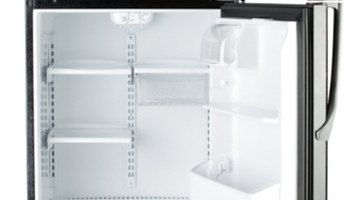What Chemicals Are Used in Refrigerators?

Refrigerators revolutionized food storage by allowing people to keep food cold at a constant and often adjustable temperature, which keeps food fresh longer. Refrigerators are complex machines that utilize numerous active and inactive chemicals to keep food cool, while wasting as little energy as possible.
Tetrafluoroethane
Tetrafluoroethane, also known as Hydro-Fluorocarbon Type 134a, is commonly used in many modern refrigerators. It begins its cycle as a gas that gradually condenses into a liquid when moving through the interior liquid coils of the refrigerator's inner workings. The liquid cools and saps heat from the interior of the fridge, and then expands once more into a now-cooled gas that is pushed through a motorized compressor and through the coils once more to begin the process anew.
Chloro-Fluorocarbon
Chloro-Fluorocarbon, or CFCs, are sparingly used in refrigerators today. It is commercially known as freon, and can still be found on older refrigerators. The chemical begins its cycle as a pressurized liquid that expands into a gas as it moves through coils within the refrigerator's walls. The gas absorbs heat, lowering the temperature in the fridge. The heated gas then moves into a motorized compressor, where the heat is removed and vented through the rear of the unit. The gas is pressurized back into a liquid when it begins the process again.
Polystyrene
Polystyrene is commonly found as coffee cups and carryout boxes at restaurants, and is a renowned insulator. As such, it is often used as padding within the interior of a refrigerator to keep heat out. It provides a barrier between the heat of the outside world and the refrigerator's enclosure that increases the cooling capacity of the active chemicals.
Acrylonitrile
Acrylonitrile is a type of plastic that acts as an excellent insulator that also provides an airtight barrier between the refrigerator's enclosure and the outside environment. It is also very easy to clean, making it ideal for refrigerators that could be sensitive to germ infestation. It typically is found along the border of a refrigerator door, and often also makes up the shelving and the interior walls.
Writer Bio
Brenton Shields began writing professionally in 2009. His work includes film reviews that appear for the online magazine Los Angeles Chronicle. He received a Bachelor of Science in social science and history from Radford University.
More Articles



